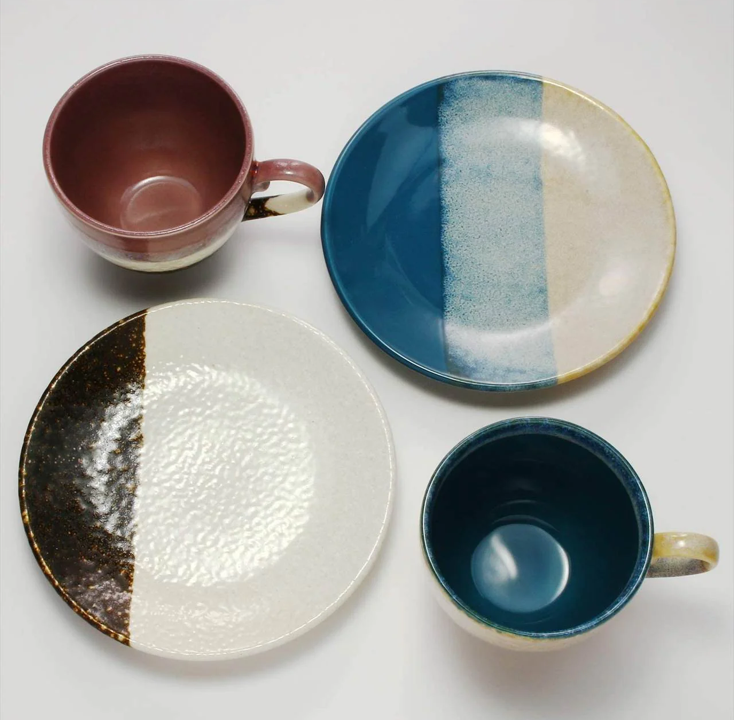News
2023.10.30
Columns
What Is Glaze? Types, Characteristics, and Application Methods in Japanese Pottery

Have you ever wondered how Japanese pottery gets its smooth, glossy finish or unique matte textures?
The secret lies in glaze, a fundamental element that not only enhances the beauty of ceramics but also plays an important role in their durability and water resistance.
In this column, we’ll explore what glaze is, its main types and classifications, how it’s applied, and the traditional concept of natural ash glaze. Whether you’re sourcing Japanese tableware or simply interested in ceramics, this guide will deepen your understanding.
Table of Contents
1. What is Glaze?
2. Main Types and Classifications of Glaze
_2-1. By Chemical Composition
_2-2. By Texture
_2-3. By Color and Firing Atmosphere
3. How Glaze Is Applied
4. What Is Natural Ash Glaze?
5. Conclusion
What is Glaze?
In ceramics, glaze is a glass-like coating applied to the surface of pottery and porcelain.
It’s typically made by mixing ash, clay, and minerals into a liquid form. The piece is dipped or coated with the glaze, then fired at high temperatures. During firing, the glaze melts and forms a smooth, protective surface.
This process not only improves the appearance—through color, shine, and patterns—but also provides:
-
Water resistance
-
Surface strength
-
A pleasant tactile feel
Glaze is essential in both functional and decorative aspects of Japanese ceramics.
Main Types and Classifications of Glaze
Glaze can be categorized in several ways: by ingredients, texture, and the colors it produces under different firing conditions.
By Chemical Composition
■Ash Glaze (Kai-Yu)
Made from natural ashes such as wood or rice straw. High-fire glaze (over 1250°C). Commonly transparent or milky white in color. Developed in Japan during the Heian period.
■Feldspar Glaze
Mainly composed of feldspar with some added ash. High-fire (1100°C+). Often produces soft white tones and natural crackle textures.
■Lead glaze
Low-fire glaze (around 800°C) using lead oxide. Produces vivid colors, often used for overglaze painting and decorations.
■Iron glaze
Iron content determines the final color. Low levels produce yellowish or celadon-like hues; higher levels yield black or dark brown tones (e.g., Tenmoku, Oribe).
■Copper glaze
Contains copper; the color outcome depends on firing conditions. Used for green (Oribe) and deep red (Shinsya) glazes.
By Texture
■Transparent glaze
Fully melts during firing and reveals the clay body underneath. Commonly used on porcelain to highlight decorations.
■Matte glaze
Appears non-glossy due to crystallization or unmelted components. Offers a subdued look but is more prone to staining and discoloration.
By Color and Firing Atmosphere
Firing atmosphere (oxidation vs. reduction) significantly affects glaze color.
*Oxidation Firing: Plenty of oxygen during firing. Metal oxides combine with oxygen and create certain color reactions.
*Reduction Firing: Limited oxygen; creates a carbon-rich atmosphere. Carbon monoxide removes oxygen from metal compounds, altering colors.
■Green glaze
High-temp Oribe glaze or low-temp glaze in ancient Sansai ware.
■Yellow glaze
Produced by iron in oxidation firing (e.g., Ki-Seto).
■Black glaze
High iron content (e.g., Seto-guro, Tenmoku).
■White glaze
Achieved through transparent glaze over white clay or milkiness in glaze (e.g., early Imari ware).
■Shinsya (Copper Red) Glaze
Copper oxide under reduction firing results in a rich red.
■Persimmon (Kaki) glaze
Iron glaze with reddish-brown to black hues.
■Celadon glaze
Iron under reduction firing turns bluish green. Famous in Korean and Japanese (Arita) traditions.
■Ruri (Cobalt Blue) Glaze
Cobalt added to feldspar glaze for a vivid deep blue.
How Glaze Is Applied
The method of application also affects the final look. Common techniques include:
・Dipping: Submerging the piece into glaze for an even coat. Requires large quantities but is beginner-friendly.
・Pouring: Glaze is poured over the surface using a ladle. Creates dynamic flow patterns.
・Spraying: Applied with a spray gun for subtle gradations and control.
・Brushing: Painted on with a brush. More manual and allows texture, but may result in unevenness.
What Is Natural Ash Glaze?
Natural ash glaze (shizen-yu) is one of the oldest glazing techniques in Japanese pottery.
Instead of applying glaze before firing, the ash from wood fuel naturally falls on the ceramic during kiln firing, melts, and forms a natural glass layer. The final appearance varies depending on kiln design, firing temperature, and atmosphere.
This method is often seen in traditional Japanese pottery such as Bizen or Shigaraki, where chance and nature define each unique piece.
Conclusion
Glaze plays a vital role in both the visual appeal and usability of ceramic ware. Even when using the same glaze formula, no two pieces turn out exactly alike due to differences in kiln conditions and firing processes. This unpredictability is part of what makes Japanese pottery so captivating.
When selecting or purchasing Japanese ceramics, understanding the glaze can deepen your appreciation—and help you choose pieces with the finish and function that best suit your needs.
About Imoto Sangyo
At Imoto Sangyo, we offer a wide range of Japanese ceramics, kitchenware, and household goods for international wholesale buyers.
To explore our product line, please visit our “Goods & Cases” page.
For inquiries about export/import services related to tableware, knives, tools, and miscellaneous goods, contact us via the Contact Form.
Note: We do not offer retail sales to individual customers.
Category
Archive

